Quantitative 3D Depositional Element Modeling of the Mishrif Carbonate Platform: Enhancing Reservoir Performance Prediction
Abstract
1. Introduction
2. Field Background
3. Materials and Methods
4. Results and Discussion
4.1. Results of High-Resolution Sequence Stratigraphy
4.1.1. Marker Layer
4.1.2. Lithofacies
4.1.3. Depositional Cycles
4.2. Analysis of Diagensis and Reservoir Petrophysical Properties
4.2.1. Diagenesis
4.2.2. Reservoir Petrophysical Properties
4.3. Sedimentary Facies Modeling and Evolution
4.3.1. Characteristic Logging Responses
4.3.2. Sedimentary Facies Modeling
4.3.3. Sedimentary Facies Evolution
5. Conclusions
Author Contributions
Funding
Data Availability Statement
Acknowledgments
Conflicts of Interest
Appendix A
| Lithofacies | Codes | Ø (He) (%) | K air (mD) | Grain Density (gm/cc) | Descriptions |
|---|---|---|---|---|---|
| Mudstones: | |||||
| Foraminiferal mudstone | LMf | / | / | / | Moderate foraminiferal and bioclast fragments set within a micritic matrix; common bioclasts with non-ferroan calcite, predominantly comprised of the foraminiferal allochems of Miliolids and sponge spicules; minor possible ostracods, benthic forams, and echinoderms. |
| Mudstone | M | / | / | / | Interbedded dark grey or black shale without bioclastic material. |
| Bioturbated mudstone | LMb | 10.5 | 0.6 | 2.723 | Locally abundant burrows with less than 10% bioclastic fragments within a micritic matrix. |
| Wackestones: | |||||
| Bioclastic peloidal wackestone | LWbp | 12.9 | 6.8 | 2.703 | Matrix supported and locally micritic pelletal material; bioclasts predominantly comprised of echinoderm plates and spines, benthic foraminifera (Orbitoids, Alveolinids, Miliolids, Textularids, Nautiloculina, Alveolinids, Discocyclina, Marginopora, biserial and uniserial forams), and indeterminate algal fragments; sponge spicules in longitudinal sections, chambered sponge tests, molluscan fragments (including bivalves and gastropod), and minor amounts of planktonic forams (Globigerinids, stromatoporoids, and indeterminate debris). |
| Bioclastic wackestone | LWb | 13.7 | 2.3 | 2.703 | Various types of bioclasts set in a micritic matrix; abundant bioclasts of planktonic and benthic forams (e.g., Miliolids, Alveolinids, Peneroplids, and uniserial types), and molluscan fragments (rudist bivalves), echinoderm plates, corals, and red algal fragments; moderately large fragments of rudist bivalves and bryozoans, sponge spicules, echinoderm plates, and fine grade forams; minor to moderate ostracods, brachiopod spines, and solitary coral. |
| Dolomitic bioclastic wackestone | LWdb | 14.5 | 6.0 | 2.725 | Matrix supported with patches of replacive dolomite; abundant bioclasts of rudist bivalve fragments and benthic forams (commonly Miliolids), moderate amounts of echinoderm, red algal, and bryozoan material; common dolomite rhombs with minor echinoderm plates, dasyclad green algal fragments, molluscan bioclast fragments of bivalves, and gastropods. |
| Dolomitic wackestone | DW | 9.4 | 0.6 | 2.729 | Wackestones showing pervasive dolomite cementation, with minor scattered bioclasts consisting of rudistid bivalve fragments, benthic forams (e.g., Miliolids), echinoderms, and molluscan fragments; a very finely crystalline mosaic of non-ferroan dolomite. |
| Packstones: | |||||
| Bioclastic peloidal packstone | LPbp | 17.8 | 25.5 | 2.704 | Grains supported by rounded to angular allochems and peloids; common bioclasts, including molluscan fragments (e.g., rudists, bivalves and gastropods), algal material, forams (e.g., Orbitoids, Peneroplids, Lituolinids, Miliolids, Lenticulinids, Nautiloculina, and Cuneolina), echinoderm plates, spines, and coralline fragments; moderate quantities of bryozoans and planktonic forams like Globigerinids. |
| Bioclastic packstone | LPb | 24.7 | 20.1 | 2.695 | Abundant bioclasts dominated by benthic forams (Miliolids, Textularids, Nautiloculina, Cuneolinids, Orbitolinids, Lituolinids, Peneroplids, Valvulinids, Alveolinids, Nautiloculina, and Discocyclina), large rudist bivalve fragments, red algal fragments, echinoderm plates, and abraded molluscan debris; moderate to common algal fragments, sponge spicules, planktonic forams, and ostracods; minor to moderate molluscan debris consisting of brachiopod spines, gastropod, bivalve, echinoderm plates, lituolinid foraminifera (shallow water), planispiral forams, and bryozoans. |
| Dolomitic bioclastic packstone | LPdb | 21.4 | 2.2 | 2.740 | Bioclasts, including benthic forams and planktonic forams such as Globigerinids; moderate molluscan (locally bored or moldic), algal, and bryozoan fragments, brachiopod spines, and minor echinoderm plates; cementation is dominated by abundant non-ferroan rhombic dolomites concentrated in irregular patches |
| Grainstones: | |||||
| Bioclastic peloidal grainstone | LGbp | 20.5 | 42.5 | 2.714 | Grain-supported texture with widespread peloidal material; moderate bioclasts consisting of molluscan (including rudistid bivalves), bryozoan fragments, and echinoderm fragments, benthic forams (Fussulinids, Textularids, Miliolids, Alveolinids, and Lepidorbitoides), and algal fragments; subordinate bioclastic fragments (likely foram debris) and widespread peloidal material; minor stromatoporoids; occasional micritized grains that sometimes resemble peloids. |
| Bioclastic grainstone | LGb | 21.9 | 189.4 | 2.704 | Grains supported by abundant bioclasts dominated by molluscan (e.g., rudistid bivalve fragments), benthic forams (e.g., Fussulinids, Textularids, and Miliolids), moderate echinoderms and local algal fragments; minor to moderately abundant stromatoporoids, calcareous sponges, bryozoans, algal, and echinoderm plates |
| Floatstones: | |||||
| Rudistid floatstone | LFr | 23.8 | 216.4 | 2.704 | Gravel fragments primarily consisting of rudist bivalves set in a micritic matrix; bioclasts, including molluscan fragments of rudist bivalves and indeterminate uniserial bioclasts with large open test chambers up to 2 × 2 mm; minor to moderate micritic allochems that appear to be bioclastic in origin, including benthic forams (e.g., Textularids, Miliolids, and Lituolinids), algal material, echinoderms plates, and granule to pebble grade coralline fragments. |
| Rudstones: | |||||
| Rudistid rudstone | LRr | 18.8 | 35.2 | 2.709 | Gravel bioclasts primarily consisting of rudist bivalve fragments composed of non-ferroan calcite; common benthic forams and microfossils that are typically leached and cemented by micrites in test chambers. |
References
- Lazim, A.A.; Ismail, M.J.; Mahdi, M.M. High Resolution Sequence Stratigraphy of the Mishrif Formation (Cenomanian-Early Turonian) at Zubair Oilfield (al-Rafdhiah Dome), Southern Iraq. Pet. Res. 2024, 9, 61–71. [Google Scholar] [CrossRef]
- Huan, W.; Lirong, D.; Xingyang, Z.; Jiquan, Y.; Beiwei, L.; Haigang, D.; Peiguang, Y.; Yifan, S. Quantitative Microfacies Analyses of a Carbonate Ramp in the Upper Cretaceous Mishrif Formation, A Oilfield in Iraq, and Paleogeography Reconstruction of the North-Eastern Arabian Plate. J. Asian Earth Sci. 2024, 259, 105896. [Google Scholar] [CrossRef]
- Zhang, L.; Zhang, W.; Li, Y.; Song, B.; Liu, D.; Deng, Y.; Xu, J.; Wang, Y. Sequence Stratigraphy, Sedimentology, and Reservoir Characteristics of the Middle Cretaceous Mishrif Formation, South Iraq. J. Mar. Sci. Eng. 2023, 11, 1255. [Google Scholar] [CrossRef]
- Wang, H.; Shi, K.; Ma, Y.; Liu, B.; Song, X.; Ge, Y.; Liu, H.; Hoffmann, R.; Immenhauser, A. Control of Depositional and Diagenetic Processes on the Reservoir Properties of the Mishrif Formation in the AD Oilfield, Central Mesopotamian Basin, Iraq. Mar. Pet. Geol. 2021, 132, 105202. [Google Scholar] [CrossRef]
- Alboshamel, R.B.A.A.; Handhal, A.M. Integrating Well Logs and Microfacies Analysis for Reservoir Facies Characterization of the Mishrif Formation, Southern Iraq. Carbonates Evaporites 2025, 40, 23. [Google Scholar] [CrossRef]
- Liu, W.; Borjigin, T.; Wang, X.; Li, M.; Hu, G.; Wang, J.; Lu, L.; Zhao, H.; Chen, Q.; Luo, H. New Knowledge of Hydrocarbon Generating Theory of Organic Matter in Chinese Marine Carbonates. Pet. Explor. Dev. 2017, 44, 159–169. [Google Scholar] [CrossRef]
- Mehrabi, H.; Yahyaei, E.; Navidtalab, A.; Rahimpour-Bonab, H.; Abbasi, R.; Omidvar, M.; Assadi, A.; Honarmand, J. Depositional and Diagenetic Controls on Reservoir Properties Along the Shallow-Marine Carbonates of the Sarvak Formation, Zagros Basin: Petrographic, Petrophysical, and Geochemical Evidence. Sediment. Geol. 2023, 454, 106457. [Google Scholar] [CrossRef]
- Liu, H.; Tian, Z.; Liu, B.; Guo, R.; Yang, D.; Deng, Y.; Yu, Y.; Shi, K. Pore Types, Origins and Control on Reservoir Heterogeneity of Carbonate Rocks in Middle Cretaceous Mishrif Formation of the West Qurna Oilfield, Iraq. J. Pet. Sci. Eng. 2018, 171, 1338–1349. [Google Scholar] [CrossRef]
- Ismail, M.J.; Ettensohn, F.R.; Handhal, A.M.; Al-Abadi, A. Facies Analysis of the Middle Cretaceous Mishrif Formation in Southern Iraq Borehole Image Logs and Core Thin-Sections as a Tool. Mar. Pet. Geol. 2021, 133, 105324. [Google Scholar] [CrossRef]
- Qiao, Z.-F.; Zhu, G.-Y.; Li, S.-L.; Shao, G.-M.; Kang, W.-J.; Sun, X.-W.; Yao, Q.-Y.; Zhang, Y. Architectural Characterization of Carbonate Tidal Channels in the Mishrif Formation, Southeastern Iraq. Pet. Sci. 2024, 21, 3790–3803. [Google Scholar] [CrossRef]
- He, Q.; Shi, K.; Ma, Y.; Liu, B.; Han, J.; Li, J.; Bai, X.; Wu, C.; McArthur, A.D.; Mountney, N.P. Evolution of Rimmed Carbonate Platform Architecture Controlled by Sea-Level Change: Insights from the Lower-Middle Cambrian of the Northern Tarim Basin, China. Mar. Pet. Geol. 2025, 171, 107215. [Google Scholar] [CrossRef]
- Wang, H.; Dou, L.; Zhang, X.; Yin, J.; Luo, B.; Shen, A.; Ji, Y.; Song, Y. Geochemistry Characterization of Diagenesis from Mishrif Reservoir Rocks in the Central Mesopotamian Basin, Iraq: Implication for the Differential Diagenesis and Petroleum Significance. Sediment. Geol. 2024, 470, 106710. [Google Scholar] [CrossRef]
- Zhong, Y.; Zhou, L.; Tan, X.; Guo, R.; Zhao, L.; Li, F.; Jin, Z.; Chen, Y. Characteristics of Depositional Environment and Evolution of Upper Cretaceous Mishrif Formation, Halfaya Oil Field, Iraq Based on Sedimentary Microfacies Analysis. J. Afr. Earth Sci. 2018, 140, 151–168. [Google Scholar] [CrossRef]
- Yu, P. Hydraulic Unit Classification of Un-Cored Intervals/Wells and Its Influence on the Productivity Performance. J. Pet. Sci. Eng. 2021, 197, 107980. [Google Scholar] [CrossRef]
- Hassanpouryouzband, A.; Armitage, T.; Cowen, T.; Thaysen, E.M.; McMahon, S.; Hajibeygi, H.; Stevenson, D.S.; Stahl, M.; Haszeldine, R.S. The Search for Natural Hydrogen: A Hidden Energy Giant or an Elusive Dream? ACS Energy Lett. 2025, 10, 3887–3891. [Google Scholar] [CrossRef]
- Hassanpouryouzband, A.; Veshareh, M.J.; Wilkinson, M.; Nick, H.M.; Ngwenya, B.T.; Haszeldine, R.S. In Situ Hydrogen Generation from Underground Fossil Hydrocarbons. Joule 2025, 9, 101809. [Google Scholar] [CrossRef]
- Sadooni, F.N. The Nature and Origin of Upper Cretaceous Basin-Margin Rudist Buildups of the Mesopotamian Basin, Southern Iraq, with Consideration of Possible Hydrocarbon Stratigraphic Entrapment. Cretac. Res. 2005, 26, 213–224. [Google Scholar] [CrossRef]
- Liu, H.; Shi, K.; Liu, B.; Song, X.; Guo, R.; Wang, G.; Wang, H. Microfacies and Reservoir Quality of the Middle Cretaceous Rumaila Formation in the AD Oilfield, Central Mesopotamian Basin, Southern Iraq. J. Asian Earth Sci. 2021, 213, 104726. [Google Scholar] [CrossRef]
- Al-Dujaili, A.N. Reservoir Rock Typing and Storage Capacity of Mishrif Carbonate Formation in West Qurna/1 Oil Field, Iraq. Carbonates Evaporites 2023, 38, 83. [Google Scholar] [CrossRef]
- Deville De Periere, M.; Durlet, C.; Vennin, E.; Caline, B.; Boichard, R.; Meyer, A. Influence of a Major Exposure Surface on the Development of Microporous Micritic Limestones—Example of the Upper Mishrif Formation (Cenomanian) of the Middle East. Sediment. Geol. 2017, 353, 96–113. [Google Scholar] [CrossRef]
- Taghavi, A.A.; Mørk, A.; Emadi, M.A. Sequence Stratigraphically Controlled Diagenesis Governs Reservoir Quality in the Carbonate Dehluran Field, Southwest Iran. Pet. Geosci. 2006, 12, 115–126. [Google Scholar] [CrossRef]
- Haq, B.U.; Al-Qahtani, A.M. Phanerozoic Cycles of Sea-Level Change on the Arabian Platform. GeoArabia 2005, 10, 127–160. [Google Scholar] [CrossRef]
- Navidtalab, A.; Heimhofer, U.; Huck, S.; Omidvar, M.; Rahimpour-Bonab, H.; Aharipour, R.; Shakeri, A. Biochemostratigraphy of an Upper Albian–Turonian Succession from the Southeastern Neo-Tethys Margin, SW Iran. Palaeogeogr. Palaeoclimatol. Palaeoecol. 2019, 533, 109255. [Google Scholar] [CrossRef]
- Al-Ameri, T.K.; Al-Marsoumi, S.W.; Al-Musawi, F.A. Crude Oil Characterization, Molecular Affinity, and Migration Pathways of Halfaya Oil Field in Mesan Governorate, South Iraq. Arab. J. Geosci. 2015, 8, 7041–7058. [Google Scholar] [CrossRef]
- Aqrawi, A.A.M.; Badics, B. Geochemical Characterisation, Volumetric Assessment and Shale-Oil/Gas Potential of the Middle Jurassic–Lower Cretaceous Source Rocks of NE Arabian Plate. GeoArabia 2015, 20, 99–140. [Google Scholar] [CrossRef]
- English, J.M.; Lunn, G.A.; Ferreira, L.; Yacu, G. Geologic Evolution of the Iraqi Zagros, and Its Influence on the Distribution of Hydrocarbons in the Kurdistan Region. AAPG Bull. 2015, 99, 231–272. [Google Scholar] [CrossRef]
- Yu, Y.; Sun, L.; Song, X.; Guo, R.; Gao, X.; Lin, M.; Yi, L.; Han, H.; Li, F.; Liu, H. Sedimentary Diagenesis of Rudist Shoal and Its Control on Reservoirs: A Case Study of Cretaceous Mishrif Formation, H Oilfield, Iraq. Pet. Explor. Dev. 2018, 45, 1075–1087. [Google Scholar] [CrossRef]
- Grötsch, J.; Suwaina, O.; Ajlani, G.; Taher, A.; El-Khassawneh, R.; Lokier, S.; Coy, G.; Weerd, E.V.D.; Weerd, D.; Masalmeh, S.; et al. The Arab Formation in Central Abu Dhabi: 3-D Reservoir Architecture and Static and Dynamic Modeling. GeoArabia 2003, 8, 47–86. [Google Scholar] [CrossRef]
- Al-Qayim, B. Stratigraphic Differentiation of the Zagros Foreland Basin Sequence, Kurdistan Region, (Northern Iraq): Impacts on Oil Accumulations. In Paleobiodiversity and Tectono-Sedimentary Records in the Mediterranean Tethys and Related Eastern Areas; Boughdiri, M., Bádenas, B., Selden, P., Jaillard, E., Bengtson, P., Granier, B.R.C., Eds.; Advances in Science, Technology & Innovation; Springer International Publishing: Cham, Switzerland, 2019; pp. 267–269. [Google Scholar] [CrossRef]
- Boix, C.; Vicens, E.; Riera, V.; Oms, O. Rudist Reef Structure: Insights from Orientation of Hippuritids at l’Espà (Campanian, Southern Pyrenees). Cretac. Res. 2023, 147, 105507. [Google Scholar] [CrossRef]
- Scholle, P.A.; Bebout, D.G.; Moore, C.H. Carbonate Depositional Environments; American Association of Petroleum Geologists: Tulsa, OK, USA, 1983. [Google Scholar] [CrossRef]
- Moore, C.H.; Wade, W.J. Summary of Early Diagenesis and Porosity Modification of Carbonate Reservoirs in a Sequence Stratigraphic and Climatic Framework. In Developments in Sedimentology; Elsevier: Amsterdam, The Netherlands, 2013; Volume 67, pp. 207–238. [Google Scholar] [CrossRef]
- Hui, G.; Chen, S.; Gu, F. Strike–Slip Fault Reactivation Triggered by Hydraulic-Natural Fracture Propagation during Fracturing Stimulations near Clark Lake, Alberta. Energy Fuels 2024, 38, 18547–18555. [Google Scholar] [CrossRef]
- Al Habsi, N.; Al Shukaili, M.; Al Tooqi, S.; Ehrenberg, S.N.; Bernecker, M. Lithofacies, Diagenesis and Reservoir Quality of Upper Shu’aiba Reservoirs in Northwestern Oman. GeoArabia 2014, 19, 145–182. [Google Scholar] [CrossRef]
- Flügel, E. Microfacies of Carbonate Rocks: Analysis, Interpretation and Application; Springer: Berlin/Heidelberg, Germany, 2010. [Google Scholar] [CrossRef]
- Deville De Periere, M.; Durlet, C.; Vennin, E.; Lambert, L.; Bourillot, R.; Caline, B.; Poli, E. Morphometry of Micrite Particles in Cretaceous Microporous Limestones of the Middle East: Influence on Reservoir Properties. Mar. Pet. Geol. 2011, 28, 1727–1750. [Google Scholar] [CrossRef]
- Hollis, C.; Vahrenkamp, V.; Tull, S.; Mookerjee, A.; Taberner, C.; Huang, Y. Pore System Characterisation in Heterogeneous Carbonates: An Alternative Approach to Widely-Used Rock-Typing Methodologies. Mar. Pet. Geol. 2010, 27, 772–793. [Google Scholar] [CrossRef]
- Brigaud, B.; Vincent, B.; Durlet, C.; Deconinck, J.-F.; Blanc, P.; Trouiller, A. Acoustic Properties of Ancient Shallow-Marine Carbonates: Effects of Depositional Environments and Diagenetic Processes (Middle Jurassic, Paris Basin, France). J. Sediment. Res. 2010, 80, 791–807. [Google Scholar] [CrossRef]
- Hui, G.; Chen, Z.; Schultz, R.; Chen, S.; Song, Z.; Zhang, Z.; Song, Y.; Wang, H.; Wang, M.; Gu, F. Intricate Unconventional Fracture Networks Provide Fluid Diffusion Pathways to Reactivate Pre-Existing Faults in Unconventional Reservoirs. Energy 2023, 282, 128803. [Google Scholar] [CrossRef]
- Kaczmarek, S.E.; Fullmer, S.M.; Hasiuk, F.J. A Universal Classification Scheme For the Microcrystals That Host Limestone Microporosity. J. Sediment. Res. 2015, 85, 1197–1212. [Google Scholar] [CrossRef]
- Scholle, P.A.; Ulmer-Scholle, D.S. A Color Guide to the Petrography of Carbonate Rocks: Grains, Textures, Porosity, Diagenesis; American Association of Petroleum Geologists: Tulsa, OK, USA, 2003; ISBN 978-0-89181-358-3. [Google Scholar] [CrossRef]
- Cox, P.A.; Wood, R.A.; Dickson, J.A.D.; Al Rougha, H.B.; Shebl, H.; Corbett, P.W.M. Dynamics of Cementation in Response to Oil Charge: Evidence from a Cretaceous Carbonate Field, U.A.E. Sediment. Geol. 2010, 228, 246–254. [Google Scholar] [CrossRef]
- Heasley, E.C.; Worden, R.H.; Hendry, J.P. Cement Distribution in a Carbonate Reservoir: Recognition of a Palaeo Oil–Water Contact and Its Relationship to Reservoir Quality in the Humbly Grove Field, Onshore, UK. Mar. Pet. Geol. 2000, 17, 639–654. [Google Scholar] [CrossRef]
- Swart, P.K.; Cantrell, D.L.; Westphal, H.; Handford, C.R.; Kendall, C.G. Origin of Dolomite in the Arab-D Reservoir from the Ghawar Field, Saudi Arabia: Evidence from Petrographic and Geochemical Constraints. J. Sediment. Res. 2005, 75, 476–491. [Google Scholar] [CrossRef]
- Azmy, K.; Knight, I.; Lavoie, D.; Chi, G. Origin of Dolomites in the Boat Harbour Formation, St. George Group, in Western Newfoundland, Canada: Implications for Porosity Development. Bull. Can. Pet. Geol. 2009, 57, 81–104. [Google Scholar] [CrossRef]
- Aqrawi, A.A.M.; Keramati, M.; Ehrenberg, S.N.; Pickard, N.; Moallemi, A.; Svånå, T.; Darke, G.; Dickson, J.A.D.; Oxtoby, N.H. The origin of dolomite in the Asmari formation (Oligocene-lower Miocene), Dezful embayment, SW Iran. J. Pet. Geol. 2006, 29, 381–402. [Google Scholar] [CrossRef]
- Hui, G.; Chen, Z.; Wang, Y.; Zhang, D.; Gu, F. An Integrated Machine Learning-Based Approach to Identifying Controlling Factors of Unconventional Shale Productivity. Energy 2023, 266, 126512. [Google Scholar] [CrossRef]
- Hui, G.; Chen, S.; He, Y.; Wang, H.; Gu, F. Machine Learning-Based Production Forecast for Shale Gas in Unconventional Reservoirs via Integration of Geological and Operational Factors. J. Nat. Gas Sci. Eng. 2021, 94, 104045. [Google Scholar] [CrossRef]
- Pranter, M.J.; Hurley, N.F.; Davis, T.L. Sequence-Stratigraphic, Petrophysical, and Multicomponent Seismic Analysis of a Shelf-Margin Reservoir: San Andres Formation (Permian), Vacuum Field, New Mexico, United States. In Seismic Imaging of Carbonate Reservoirs and Systems; Eberli, G.P., Masaferro, J.L., Sarg, J.F., Eds.; American Association of Petroleum Geologists: Tulsa, OK, USA; Shell International Exploration & Production B.V.: Hague, The Netherlands, 2004; pp. 59–89. [Google Scholar] [CrossRef]
- Dandekar, A.Y. Petroleum Reservoir Rock and Fluid Properties, 2nd ed.; CRC Press: Boca Raton, FL, USA, 2013. [Google Scholar] [CrossRef]
- Smith, L.B.; Eberli, G.P.; Masaferro, J.L.; Al-Dhahab, S. Discrimination of Effective from Ineffective Porosity in Heterogeneous Cretaceous Carbonates, Al Ghubar Field, Oman. AAPG Bull. 2003, 87, 1509–1529. [Google Scholar] [CrossRef]
- Quadir, A.; Lewis, C.; Rau, R.-J. The Spontaneous Ray Log: A New Aid for Constructing Pseudo-Synthetic Seismograms. Pure Appl. Geophys. 2018, 175, 2093–2120. [Google Scholar] [CrossRef]
- Farzaneh, S.A.; Dehghan, A.A.; Lakzaie, A. Using Diagenetic Processes in Facies Modeling of a Carbonate Reservoir. Energy Sources Part A Recovery Util. Environ. Eff. 2013, 35, 516–528. [Google Scholar] [CrossRef]
- Zeng, H.; Xu, Z.; Liu, W.; Janson, X.; Fu, Q. Seismic-Informed Carbonate Shelf-to-Basin Transition in Deeply Buried Cambrian Strata, Tarim Basin, China. Mar. Pet. Geol. 2022, 136, 105448. [Google Scholar] [CrossRef]
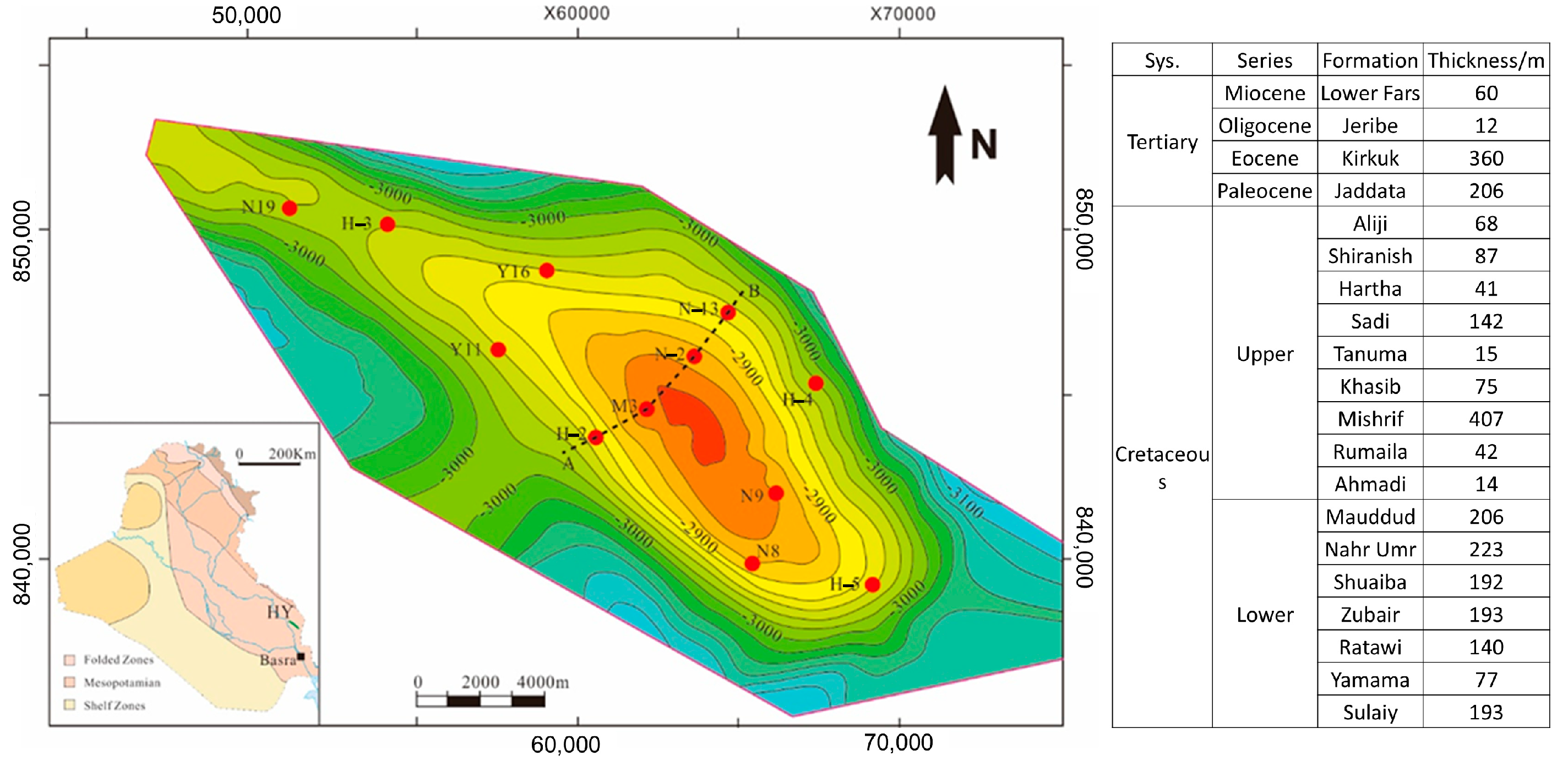
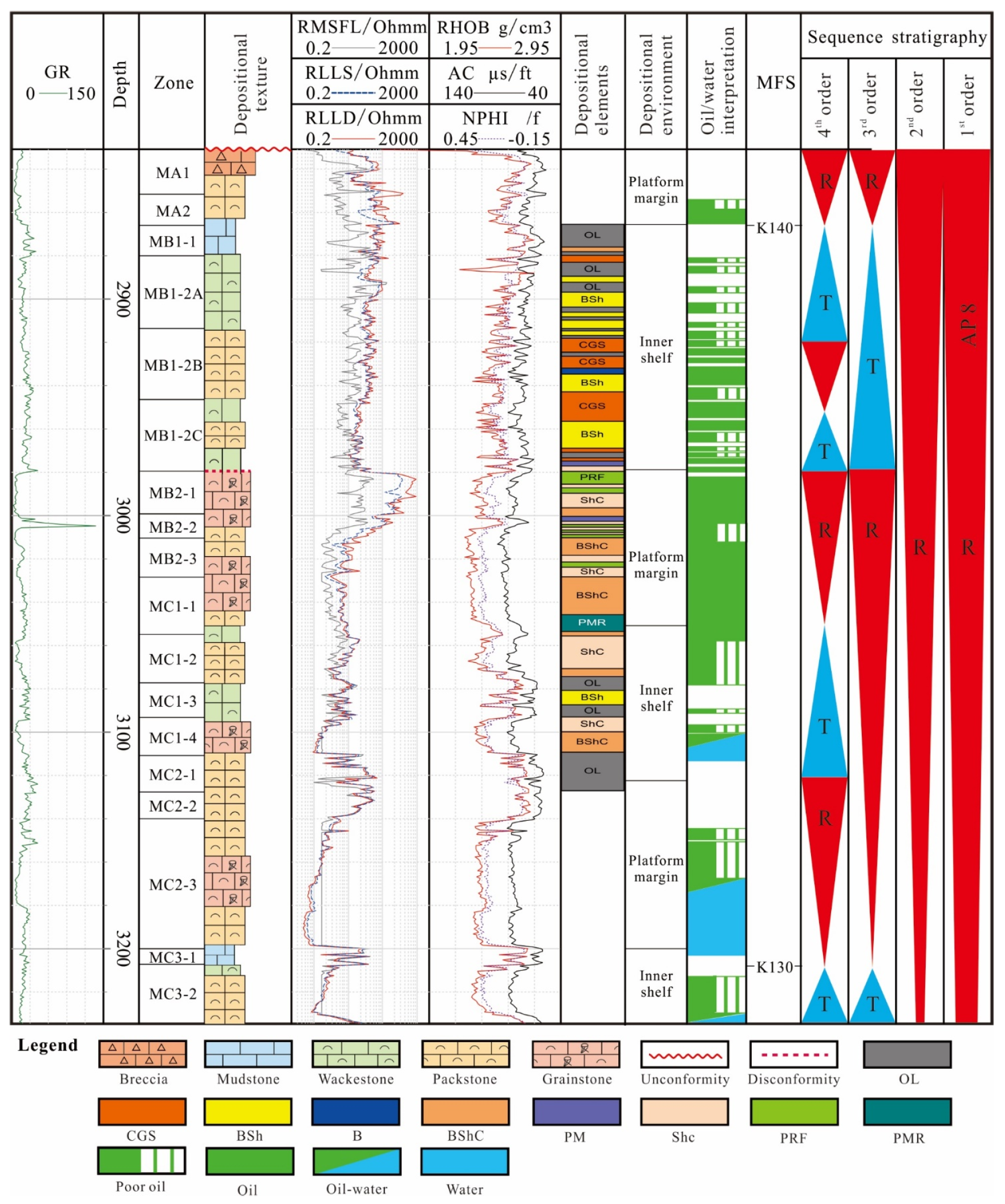
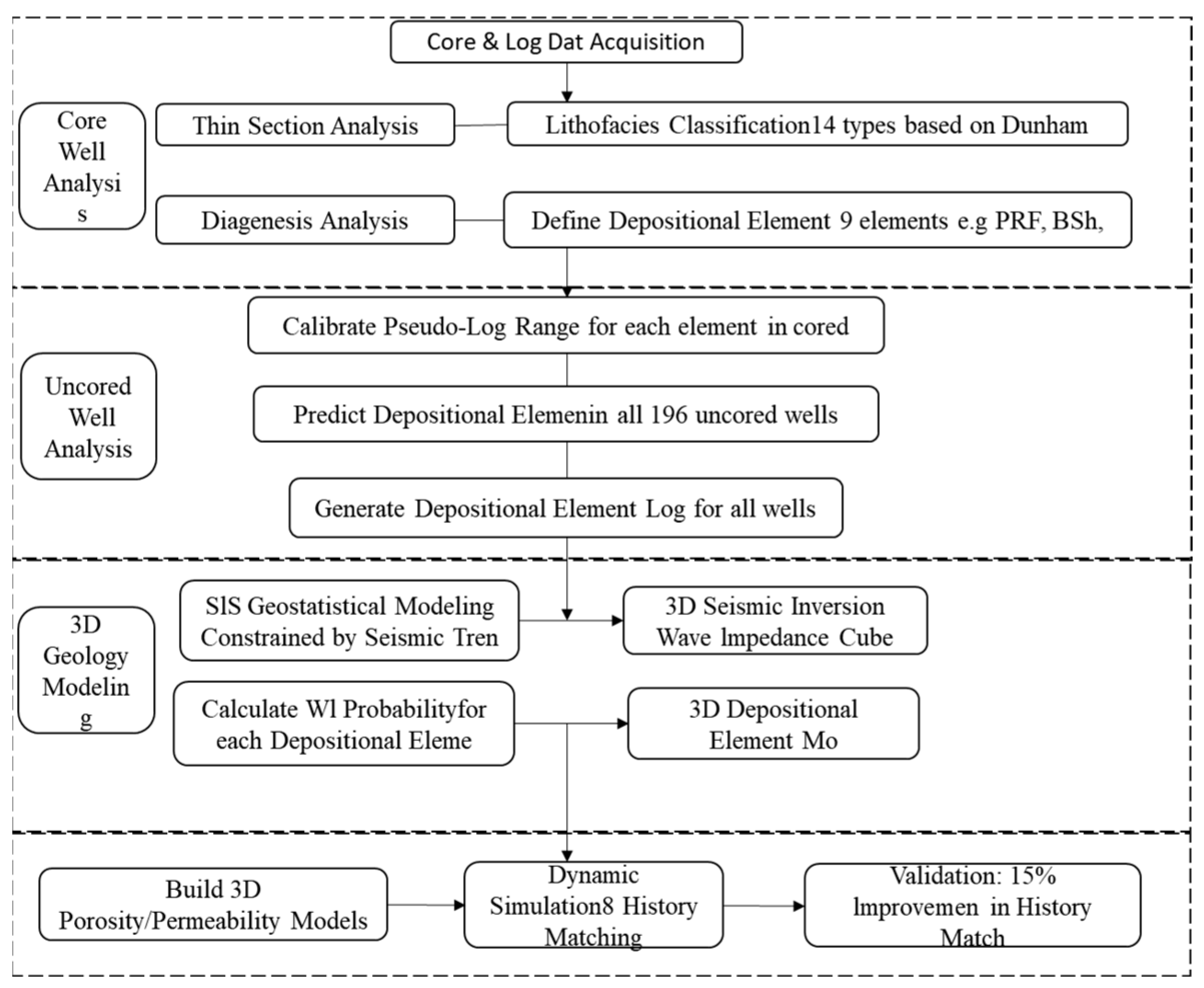
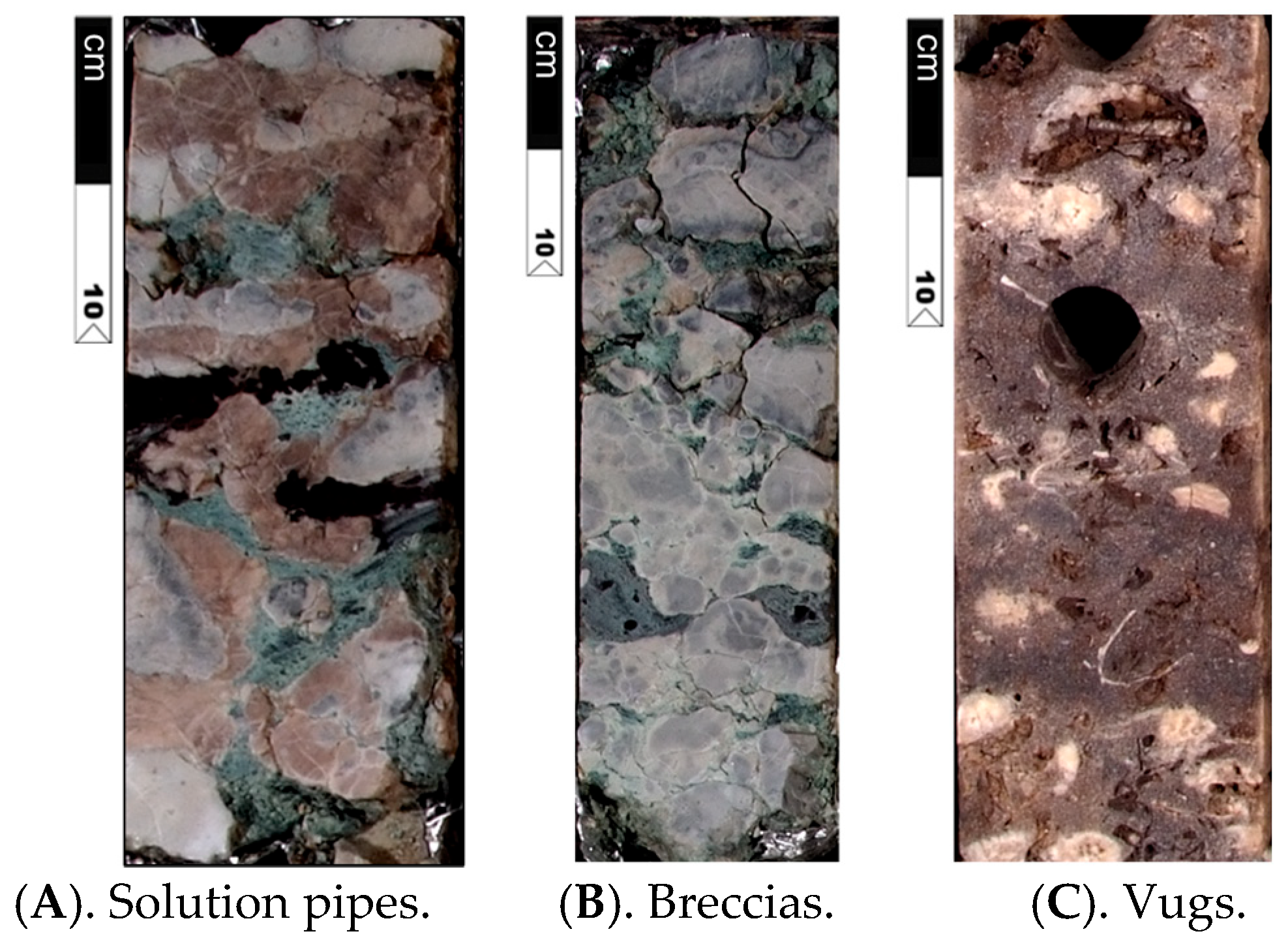
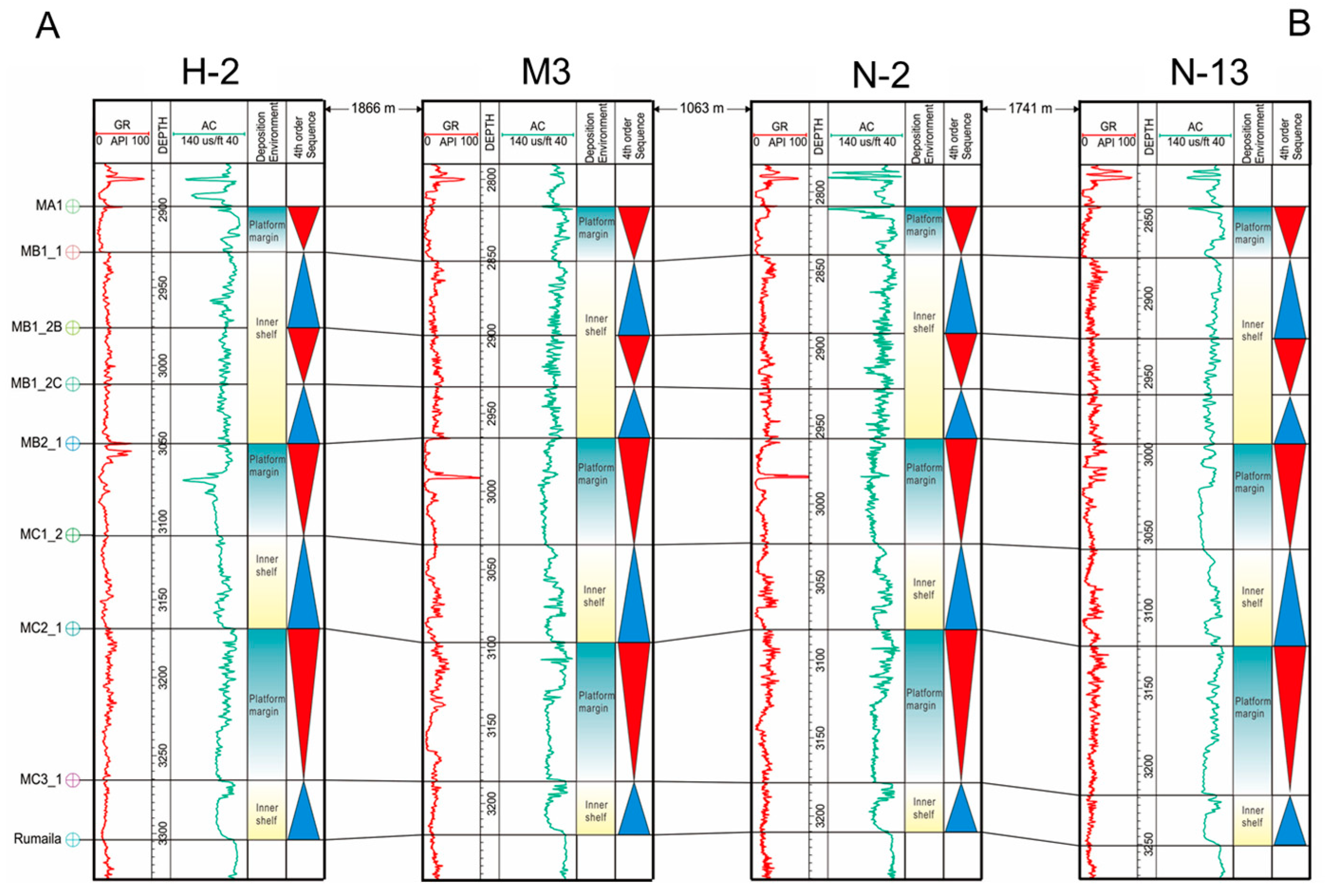
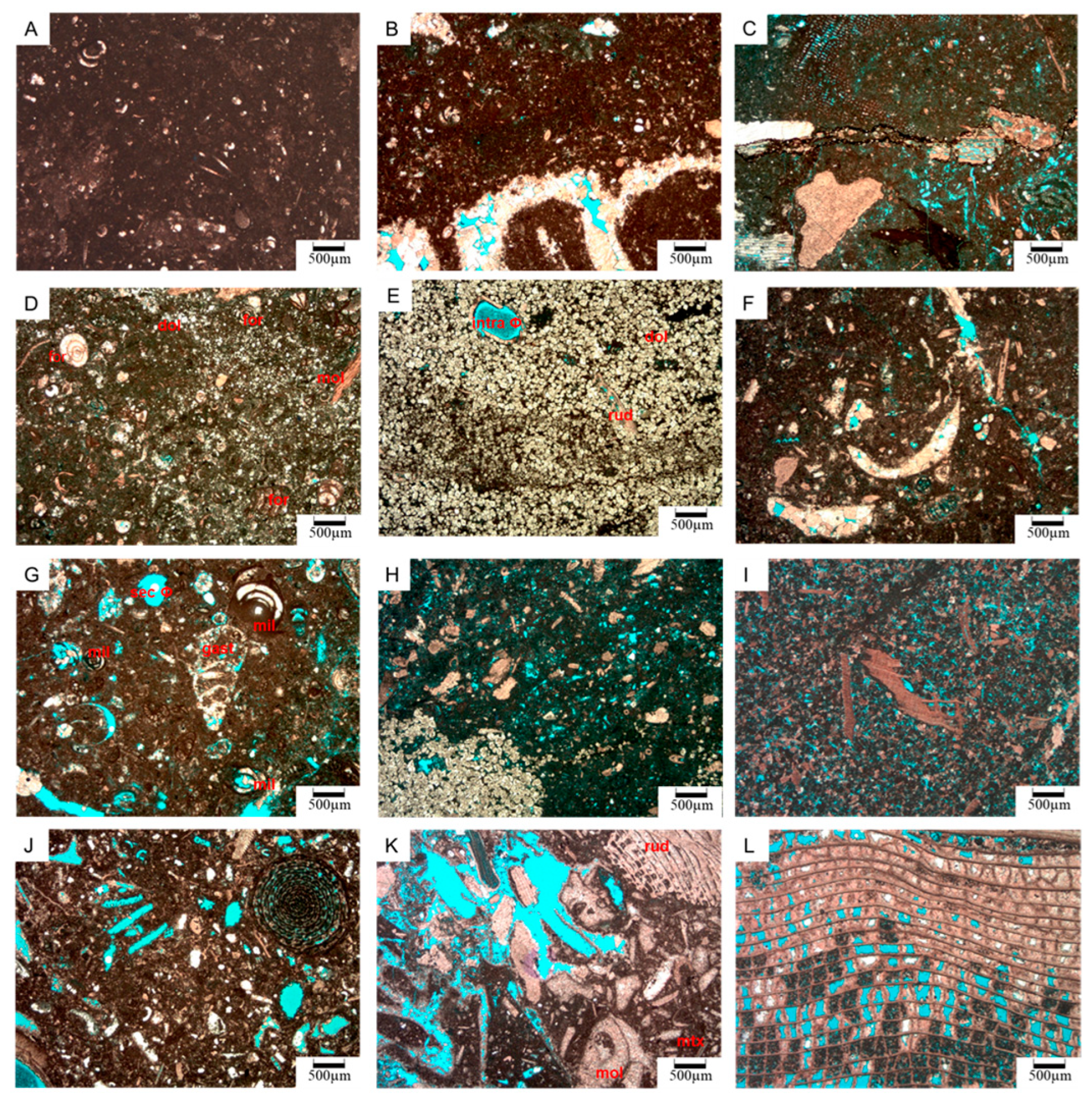

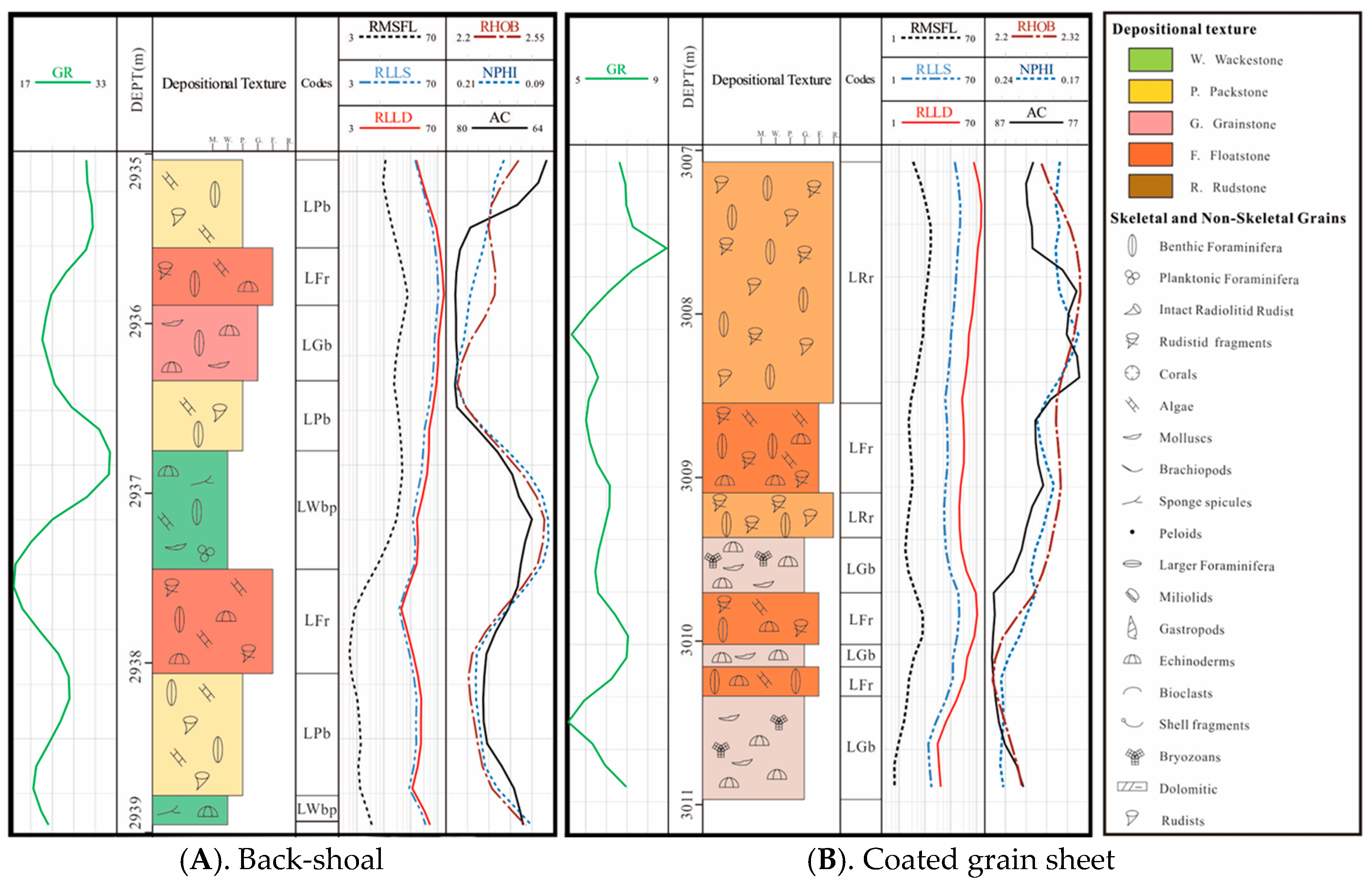

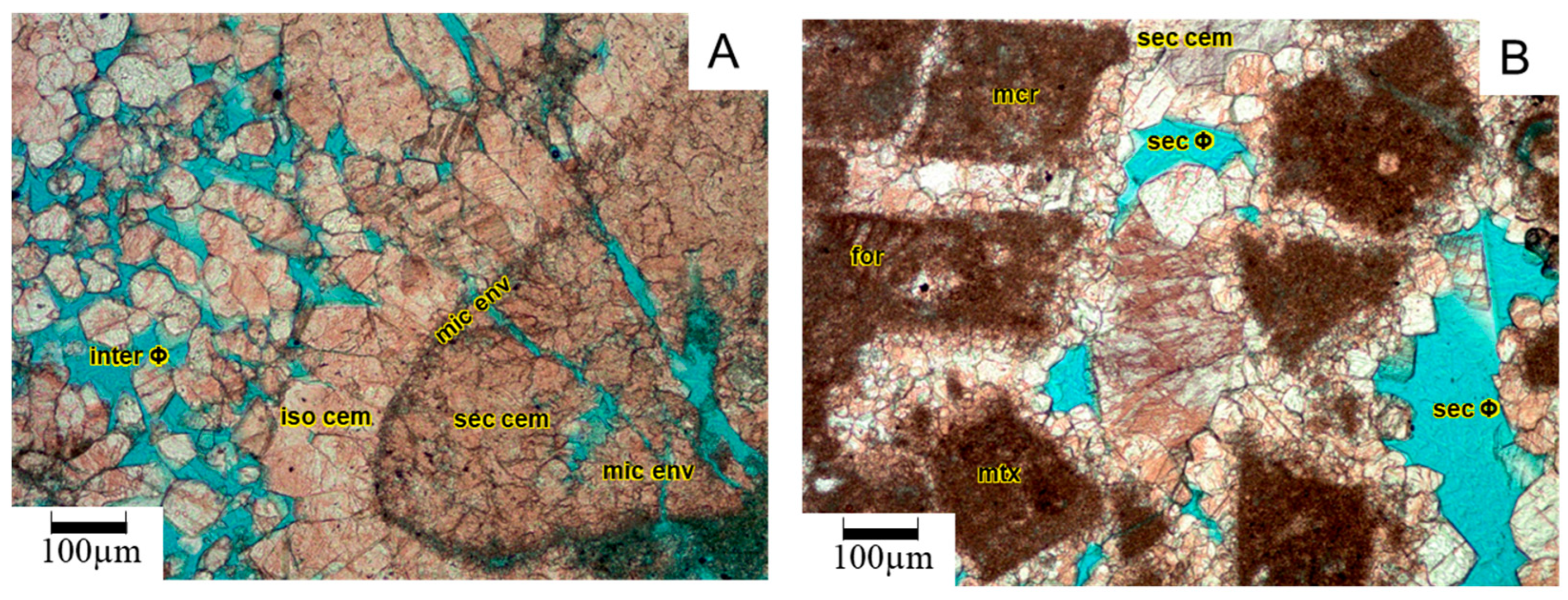

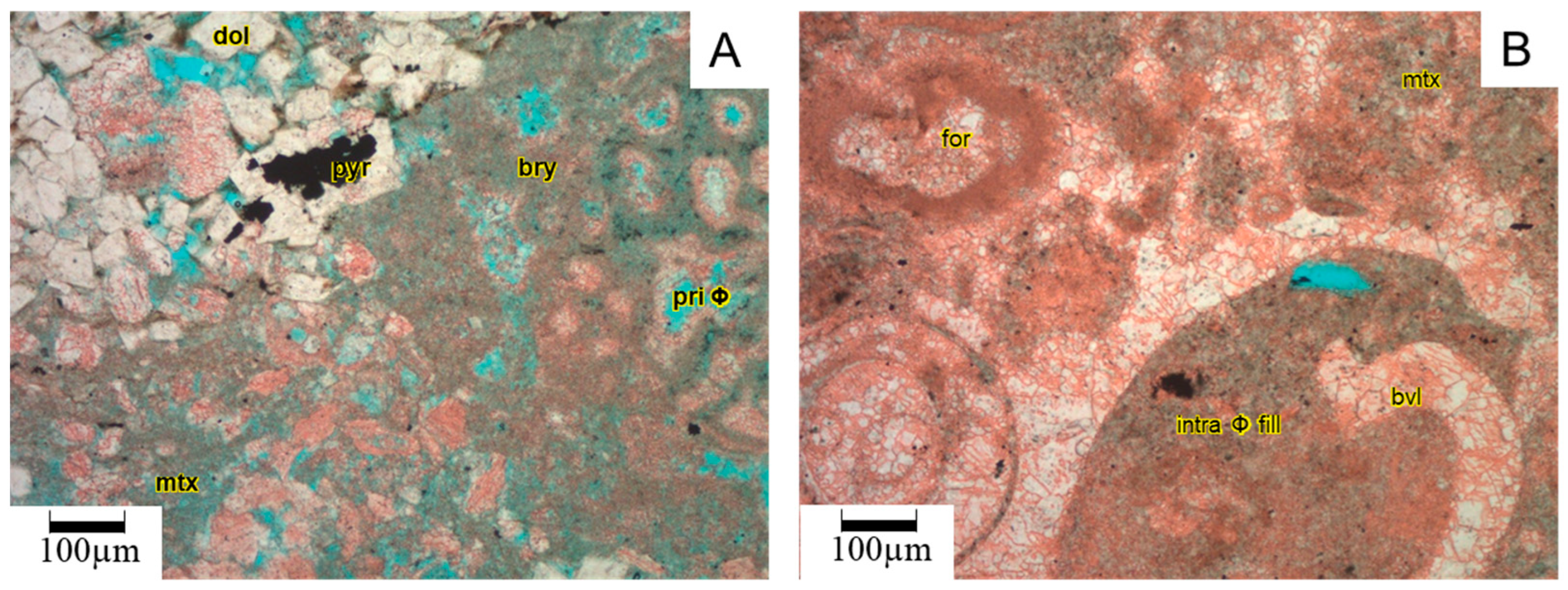
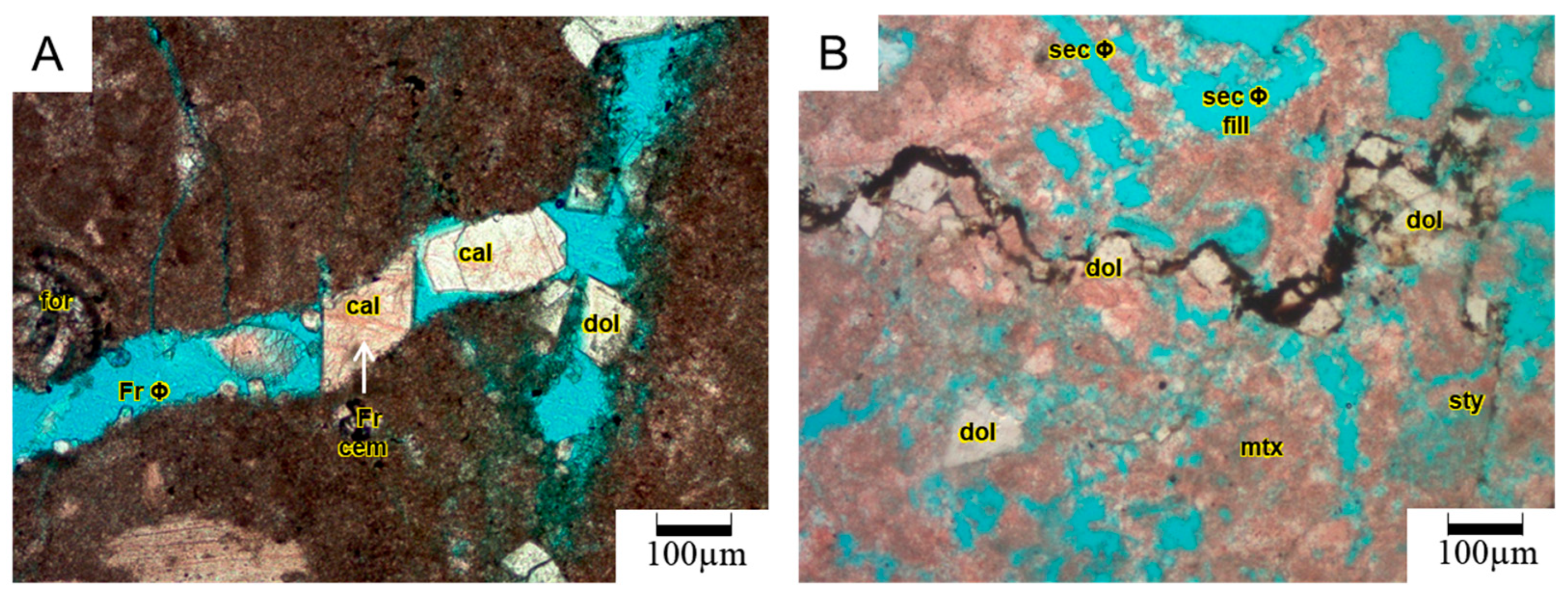
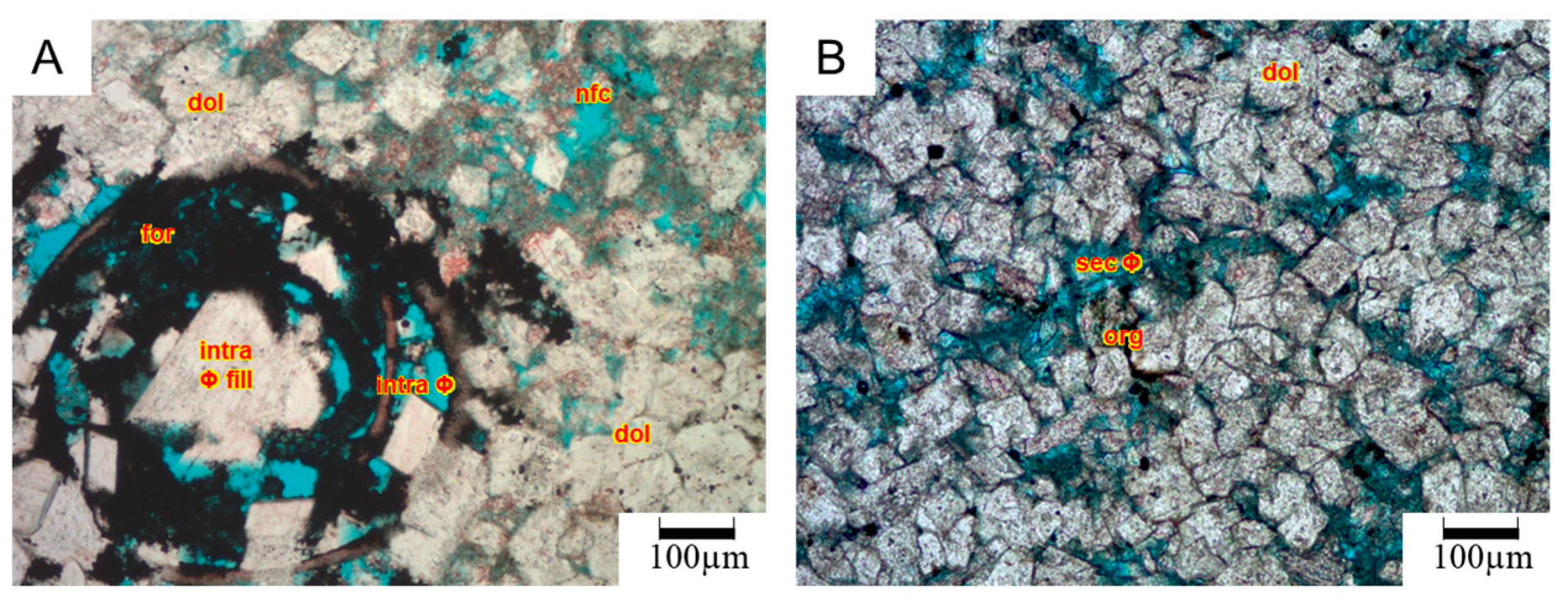
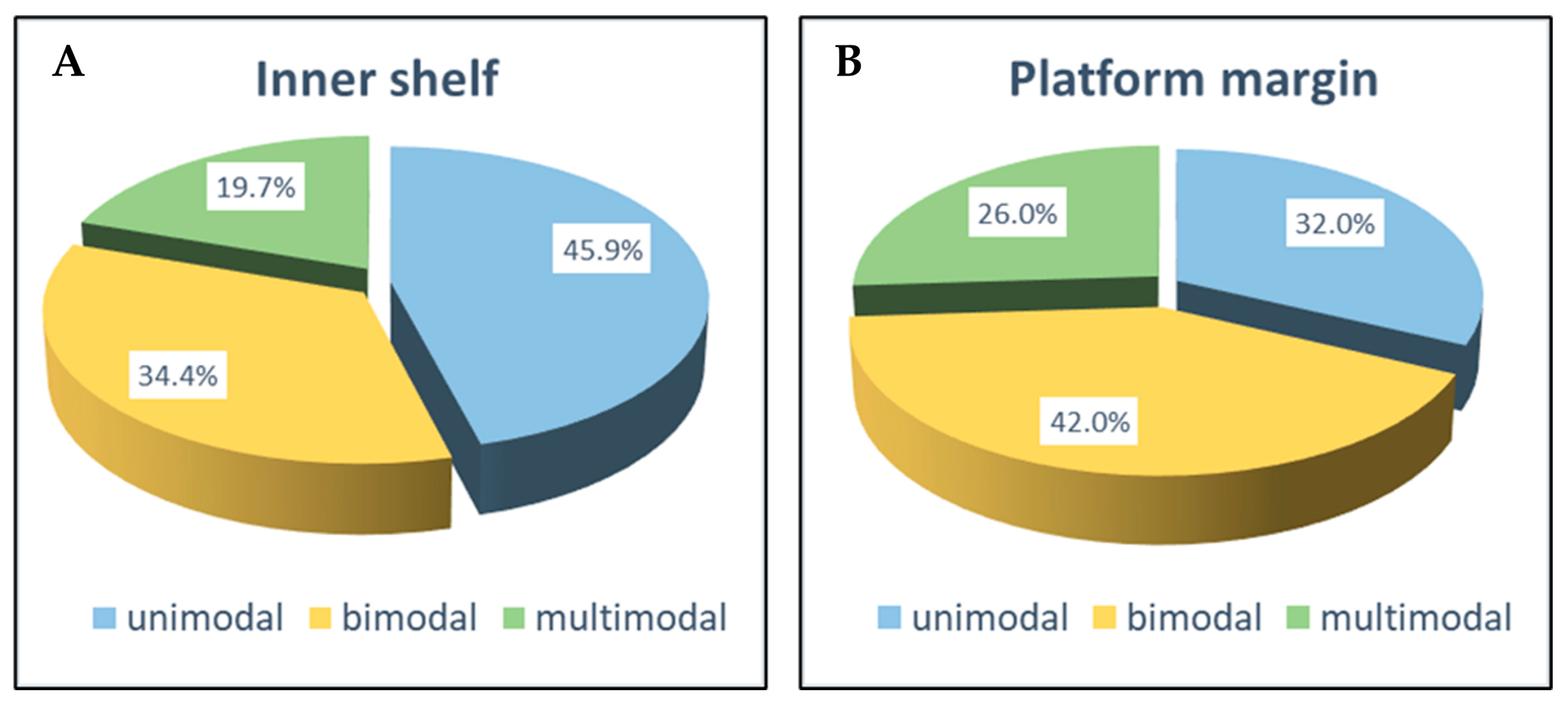

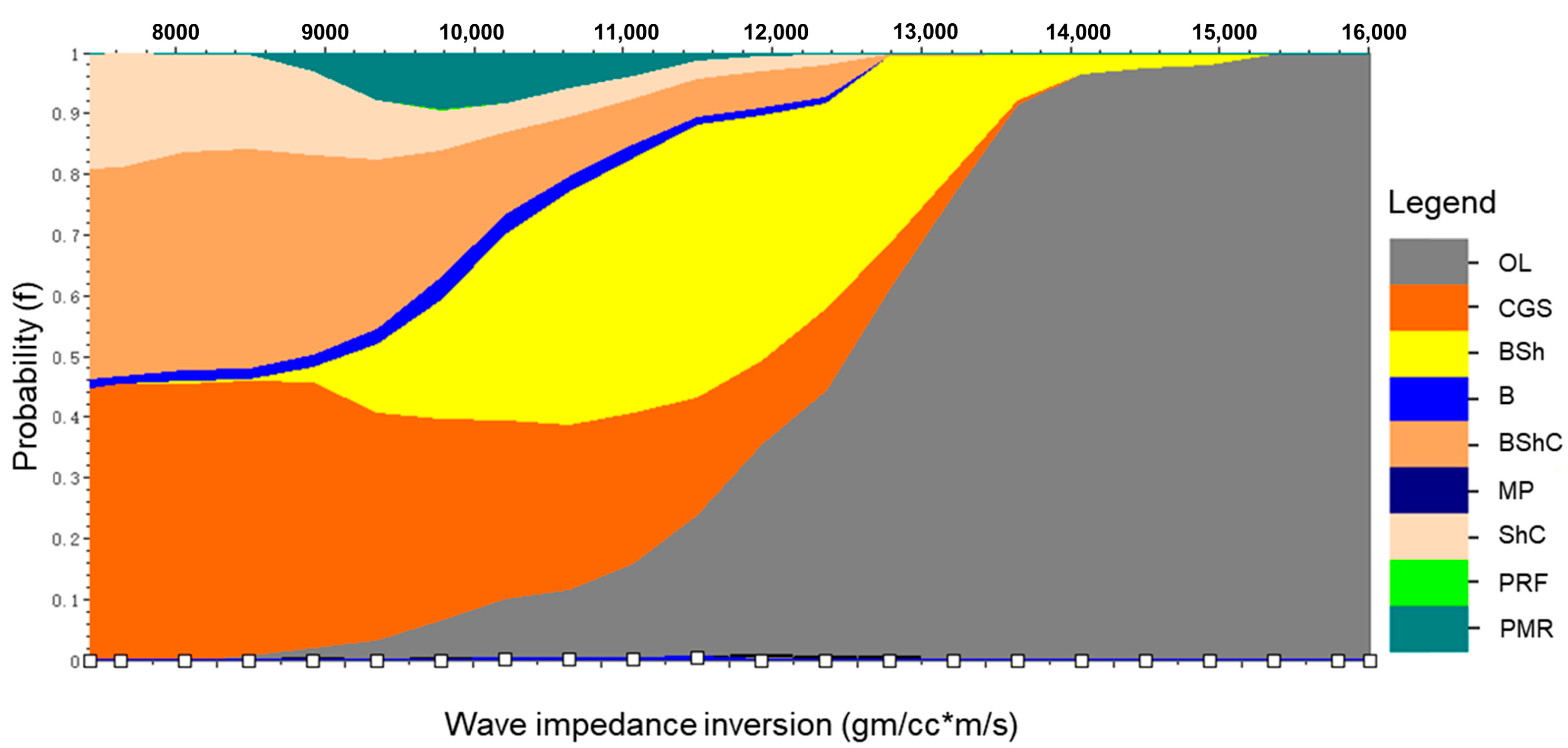


| Properties | Biostrome | Coated Grain Sheet | Back-Shoal | Shoal Complex | Patch Rudistid Reef | Back-Shoal Complex | ||||||||||||
|---|---|---|---|---|---|---|---|---|---|---|---|---|---|---|---|---|---|---|
| Min. | Max. | Ave. | Min. | Max. | Ave. | Min. | Max. | Ave. | Min. | Max. | Ave. | Min. | Max. | Ave. | Min. | Max. | Ave. | |
| Porosity (%) | 6.4 | 35.4 | 21.5 | 5.5 | 29.5 | 19.0 | 4.6 | 29.1 | 15.7 | 4.0 | 31.0 | 22.8 | 15.1 | 33.9 | 23.5 | 4.6 | 30.9 | 21.2 |
| Permeability (mD) | 0.1 | 77.2 | 21.8 | 0.2 | 49.6 | 10.0 | 0.1 | 185.4 | 6.5 | 0.1 | 1605.5 | 125.0 | 4.5 | 573.3 | 125.9 | 0.2 | 225.9 | 23.6 |
| Gain Density (gm/cc) | 2.690 | 2.726 | 2.704 | 2.650 | 2.754 | 2.704 | 2.672 | 2.797 | 2.703 | 2.679 | 2.730 | 2.704 | 2.696 | 2.731 | 2.706 | 2.687 | 2.776 | 2.709 |
| R35 (μm) | 0.16 | 1.98 | 0.8 | 0.1 | 7.98 | 1.3 | 0.05 | 4.6 | 0.66 | 0.16 | 13.52 | 3.35 | 0.63 | 6.62 | 4.15 | 0.16 | 4.92 | 1.68 |
| Pore-Throat Sorting (f) | 1.59 | 2.02 | 1.83 | 1.4 | 5.04 | 2.11 | 1.47 | 3.96 | 1.92 | 1.42 | 7.11 | 3.15 | 1.52 | 6.2 | 3.12 | 1.4 | 3.91 | 2.14 |
| Depositional Elements | GR (API) | RLLD (Ohmm) | RHOB (gm/cc) | AC (μs/ft) | RLLD*RHOB (Ohmm*gm/cc) | GR*AC (API*μs/ft) |
|---|---|---|---|---|---|---|
| Biostromes | 24.7 | 40.2 | 2.362 | 72.6 | 95.2 | 1796 |
| Coated grain sheets | 22.2 | 50.2 | 2.396 | 71.3 | 120.4 | 1581 |
| Back-shoals | 19.4 | 75.9 | 2.516 | 66.6 | 191.3 | 1291 |
| Shoal complexes | 5.7 | 289.2 | 2.356 | 75.2 | 682.6 | 427 |
| Patchy rudist reefs | 6.6 | 34.6 | 2.269 | 82.6 | 78.5 | 548 |
| Back-shoal complexes | 17.6 | 10.1 | 2.266 | 82.1 | 22.9 | 1442 |
Disclaimer/Publisher’s Note: The statements, opinions and data contained in all publications are solely those of the individual author(s) and contributor(s) and not of MDPI and/or the editor(s). MDPI and/or the editor(s) disclaim responsibility for any injury to people or property resulting from any ideas, methods, instructions or products referred to in the content. |
© 2025 by the authors. Licensee MDPI, Basel, Switzerland. This article is an open access article distributed under the terms and conditions of the Creative Commons Attribution (CC BY) license (https://creativecommons.org/licenses/by/4.0/).
Share and Cite
Li, S.; Han, R.; Pi, Z.; Hui, G.; He, H. Quantitative 3D Depositional Element Modeling of the Mishrif Carbonate Platform: Enhancing Reservoir Performance Prediction. Processes 2025, 13, 2941. https://doi.org/10.3390/pr13092941
Li S, Han R, Pi Z, Hui G, He H. Quantitative 3D Depositional Element Modeling of the Mishrif Carbonate Platform: Enhancing Reservoir Performance Prediction. Processes. 2025; 13(9):2941. https://doi.org/10.3390/pr13092941
Chicago/Turabian StyleLi, Shunming, Rubing Han, Zhiyang Pi, Gang Hui, and Hui He. 2025. "Quantitative 3D Depositional Element Modeling of the Mishrif Carbonate Platform: Enhancing Reservoir Performance Prediction" Processes 13, no. 9: 2941. https://doi.org/10.3390/pr13092941
APA StyleLi, S., Han, R., Pi, Z., Hui, G., & He, H. (2025). Quantitative 3D Depositional Element Modeling of the Mishrif Carbonate Platform: Enhancing Reservoir Performance Prediction. Processes, 13(9), 2941. https://doi.org/10.3390/pr13092941







